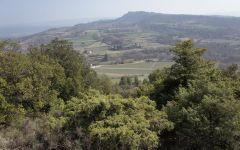Anne Pichon Sauvage Roussanne 2016


Product Details
Your Rating
Somm Note
Winemaker Notes
The micro-climate Anne Pichon’s vineyard is dry, with cool, manually tilled soils that retain moisture when it rains. And because of the Mistral that sweeps up from the hills below, fruit is less susceptible to rot and disease, providing and ideal environment for organic viticulture. White wines are made from only a light pressing of first run juice and vinified in stainless steel tanks with strict temperature control to maintain a balance of ripe fruit and freshness.






Anne Pichon and her late husband, Marc Pichon, started an agrarian-bohemian life together in the 1990’s when they moved into an abandoned farm house at the base of Mont Ventoux. The began to resurrect a defunct Domaine called Murmurium, meaning “the buzzing song of bees.” And while the 15 hectare vineyard was in poor shape, the site was properly organic for many years leading up to Anne and Marc’s stewardship. Today, Anne produces no more than 40 barrels of wine for T. Edward along with her sister-in-law Véronique who manages the commercial affairs. The wines themselves are named “Sauvage” inspired by the Pichons’ respect for and attachment to nature.
The micro-climate Anne Pichon’s vineyard is dry, with cool, manually tilled soils that retain moisture when it rains. And because of the Mistral that sweeps up from the hills below, fruit is less susceptible to rot and disease, providing and ideal environment for organic viticulture. Employing careful vineyard management, low yields and late harvesting, Pichon hand-harvests and destems all of the fruit.
Reds are vinified in small 50 HL cement tanks or stainless steel, at low temperature to achieve a long maceration and two gentle pump overs daily, with additional manual punch downs if necessary. The fermentations extend 3 to 4 weeks with a slow progressive increase in temperature to extract a very fine tannin structure. The malolactic fermentation and ageing take place partly in oak barrels but mostly in cements tanks. White wines are made from only a light pressing of first run juice and vinified in stainless steel tanks with strict temperature control to maintain a balance of ripe fruit and freshness.

Full and silky in body but also charmingly crisp, Roussanne is native to the Rhône Valley of France. It is responsible for some of the finest Northern Rhône white wines. Roussanne adds richness and acidity to Marsanne’s soft, fruitiness, making age worthy and highly respected whites. Somm Secret—Roussanne takes its name from the French word, roux, meaning rouge or red because of the berry’s pink glow. In California, virtually all of the 339 acres of Roussanne come from true clones brought over by Tablas Creek and John Alban.

A long and narrow valley producing flavorful red, white, and rosé wines, the Rhône is bisected by the river of the same name and split into two distinct sub-regions—north and south. While a handful of grape varieties span the entire length of the Rhône valley, there are significant differences between the two zones in climate and geography as well as the style and quantity of Rhône wines produced. The Northern Rhône, with its continental climate and steep hillside vineyards, is responsible for a mere 5% or less of the greater region’s total output. The Southern Rhône has a much more Mediterranean climate, the aggressive, chilly Mistral wind and plentiful fragrant wild herbs known collectively as ‘garrigue.’
In the Northern Rhône, the only permitted red variety is Syrah, which in the appellations of St.-Joseph, Crozes-Hermitage, Hermitage, Cornas and Côte-Rôtie, it produces velvety black-fruit driven, savory, peppery red wines often with telltale notes of olive, game and smoke. Full-bodied, perfumed whites are made from Viognier in Condrieu and Château-Grillet, while elsewhere only Marsanne and Roussanne are used, with the former providing body and texture and the latter lending nervy acidity. The wines of the Southern Rhône are typically blends, with the reds often based on Grenache and balanced by Syrah, Mourvèdre, and an assortment of other varieties. All three northern white varieties are used here, as well as Grenache Blanc, Clairette, Bourbelenc and more. The best known sub-regions of the Southern Rhône are the reliable, wallet-friendly Côtes du Rhône and the esteemed Châteauneuf-du-Pape. Others include Gigondas, Vacqueyras and the rosé-only appellation Tavel.
